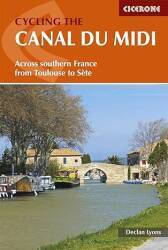
Marseille to Béziers
Arrival in Marseille
We began our trip by flying into Marseille.
I arrived first for a few days on my own.
I had set up the trip for my parents and
close friends of theirs.
They would fly into Marseille
and I would meet them at the airport.
We would take the airport bus into the city,
to the main train station, and store their bags.
Then they would have a quick look around the city.
Down to the port area, through the markets, lunch at a
North African place.
Then in the afternoon we would return to the train station,
retrieve our bags, and board a train to
Béziers.
The following day we would look around Béziers.
The day after that, we would pick up our boat and start
a week-long trip along the Canal du Midi.
I had arranged the canal trip and other stages,
I would be le transporteur.
Amazon
ASIN: B000I9VZEI
Amazon
ASIN: B008Y70P92
The Basilique Nôtre Dame de la Garde overlooks the Vieux Port, the central harbor. Today it's used by pleasure craft and small fishing boats.
Marseille is France's largest port, with enormous container ships constantly moving in and out of its new freight port a few kilometers to the north.
You see CMA CGM containers moving all over the world on enormous ships and also trucks and trains. That shipping company is based in Marseille and operates out of 420 ports around the world. Marseille is also the home of COMEX or Compagnie Maritime d'Expertises, a world leader in sub-sea engineering.

The busy markets have food from all over France, Italy, and Spain, and from across the Mediterranean in Africa.
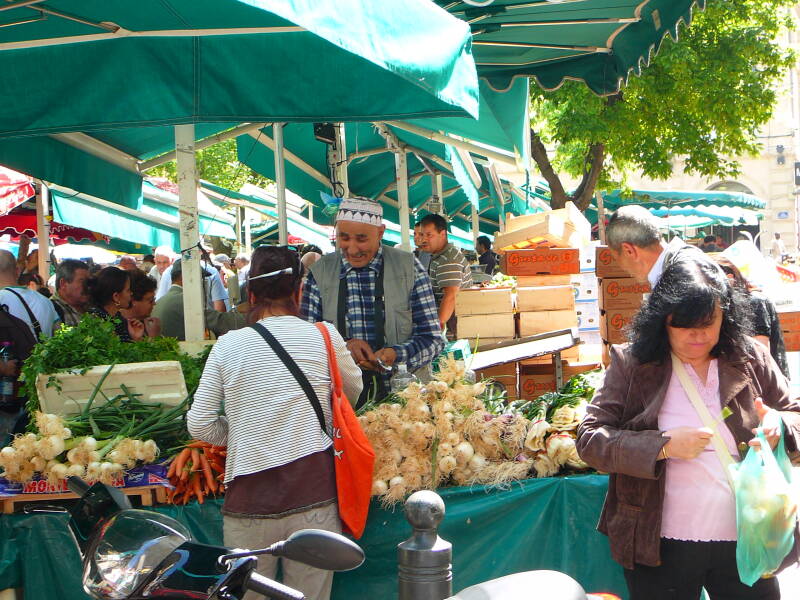
I had a few days to recover from jet lag, get back up to speed on getting by in French, and relax and observe the Marseillais.
VisitingMarseille
The city has been a cosmopolitan port since it was founded by Greek settlers around 600 BCE. They called it Μασσαλία, which we spell Massalia or Massilia.
It was the first Greek settlement in what is today's France with the status of πολίς, or city.
The natural harbor had made this an obvious place to settle. By the mid 300s BCE the colony was quite wealthy. They established the Treasury of Massalia at the major religious complex at Delphi back in central Greece.
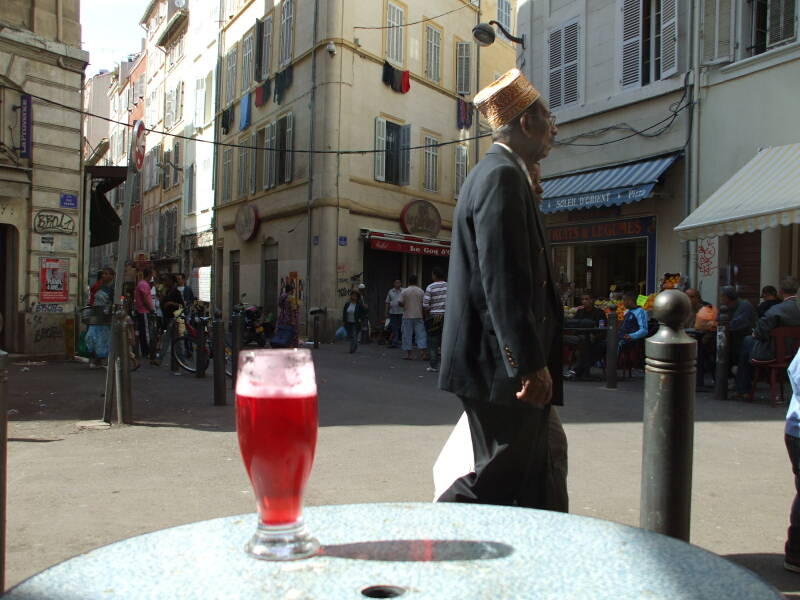
By Train to Béziers
Soon it was time to move on. I stored my bag at the Vertigo Hostel where I had been staying near the Saint Charles station, the main train station in Marseille. I took the bus out to the airport and met my parents and their friends.
We came in to the city — through the markets to the port, lunch at a Tunisian couscous place, some sightseeing through mid-afternoon, then back to the station.

Tickets to Béziers were just € 30.10.
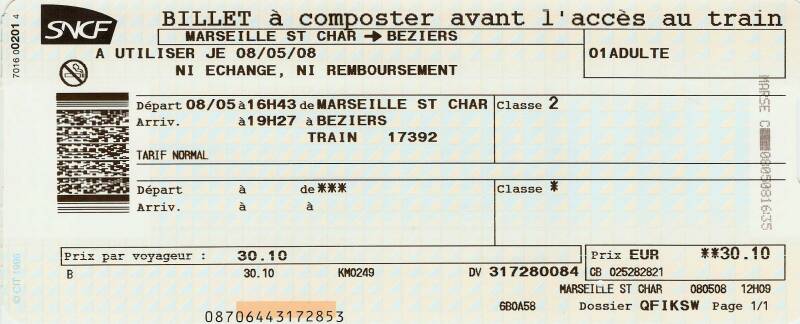
You must stamp your ticket in the compostage machine before going out onto the platform.
In the U.S., there's constant adult supervision with announcements treating everyone as dim-witted self-destructive children. Outside the U.S., there's no hand-holding. You have to know what you're doing.
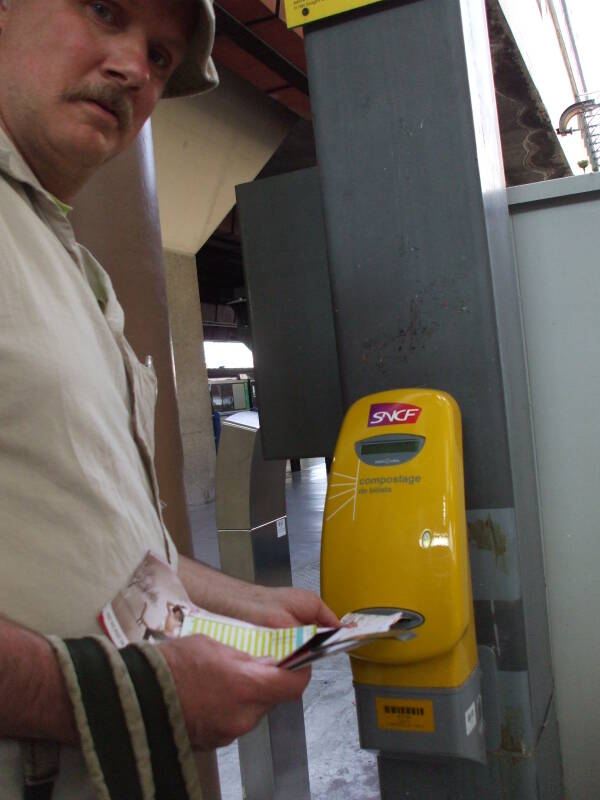
Here we go! Onto the RER la Région Languedoc Roussillon, the regional train.
My mom, Betty, in white; Shirley closest to me; my dad, Bill, in a white hat; and Larry behind him in a blue shirt.
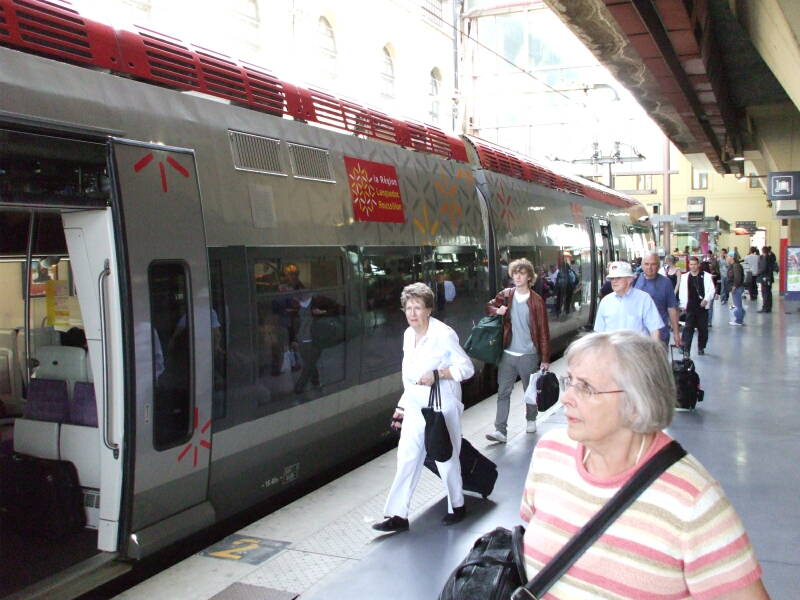
Béziers
Béziers
About two hours and forty-five minutes later we arrived at the SNCF station in Béziers.
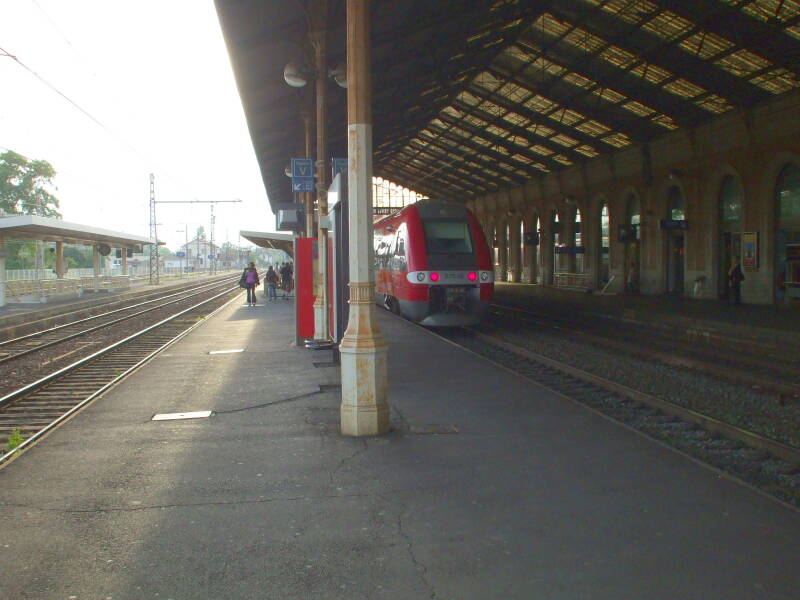
We got a taxi to the Hôtel Champ de Mars. Larry is checking out his balcony, Betty is at the door. It was € 43 for a double room, € 37 for a single.
Amazon
ASIN: 2017068365
Notice the Guide du Routard placards along either side of the door. I have been very happy with that guidebook series' suggestions. Its placards are a good sign.

Exploring Béziers
Everyone else was exhausted after an overnight flight to Amsterdam and a connecting flight, then a pretty full day of sightseeing in Marseille. But the next morning after breakfast it was time to explore Béziers.
NeolithicFrance
It's an old city. The site has been occupied since Neolithic times.
It has been an organized community since 575 BCE, making it slightly newer than Marseille.
Rome rebuilt it in 36-35 BCE as Colonia Julia Baeterrae Septimanorum, a new colonia for military veterans. On the road from Provence to Iberia, it exported white wine to Rome.

If you need more coffee, stop in a tabac as the locals do. Lean on the tin countertop. Ask for café, that gets you espresso. Maybe un double.
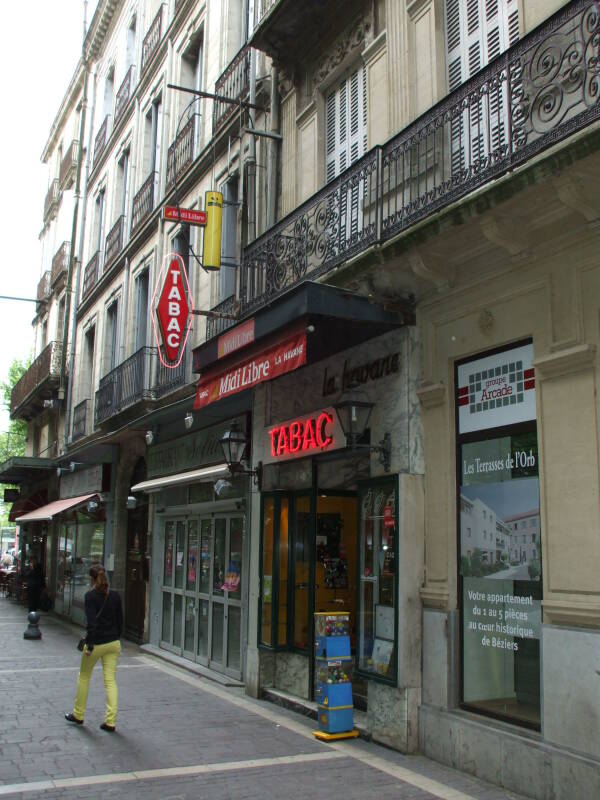
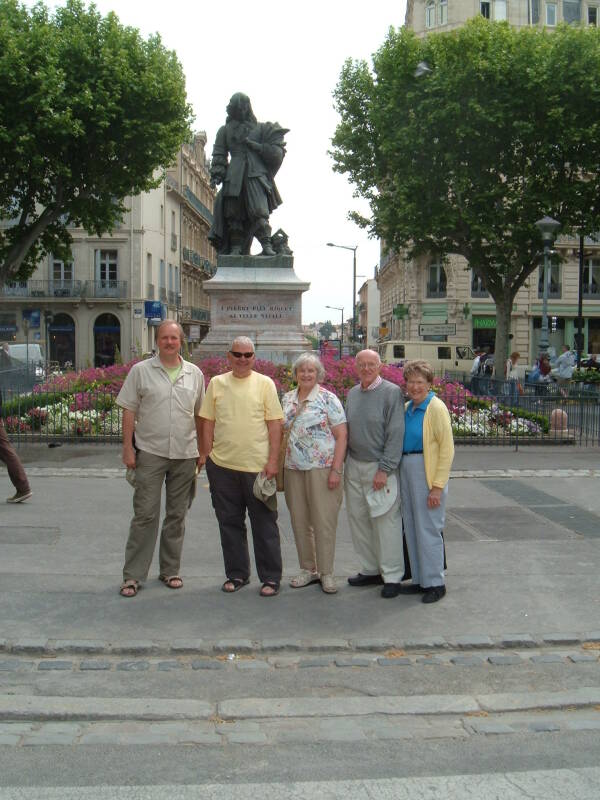
Here we are — me, Larry and Shirley, and my parents Bill and Betty.
Behind us is a statue of Pierre-Paul Riquet, the designer of the Canal du Midi.
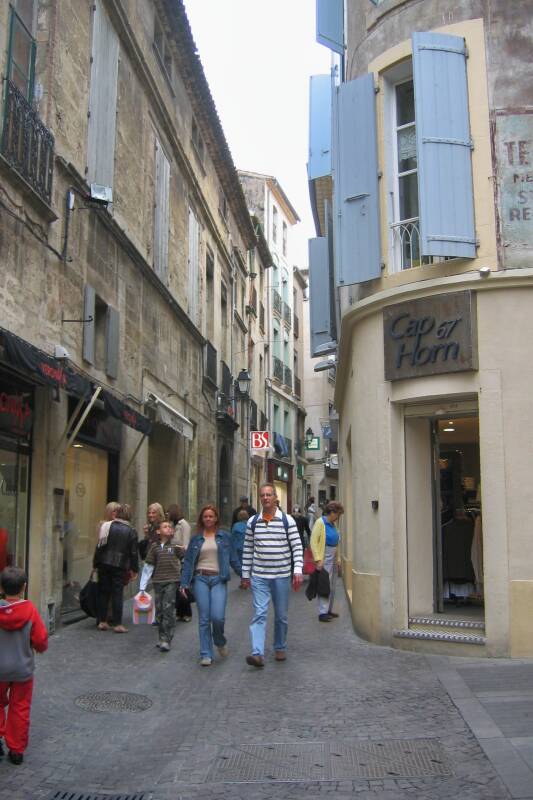
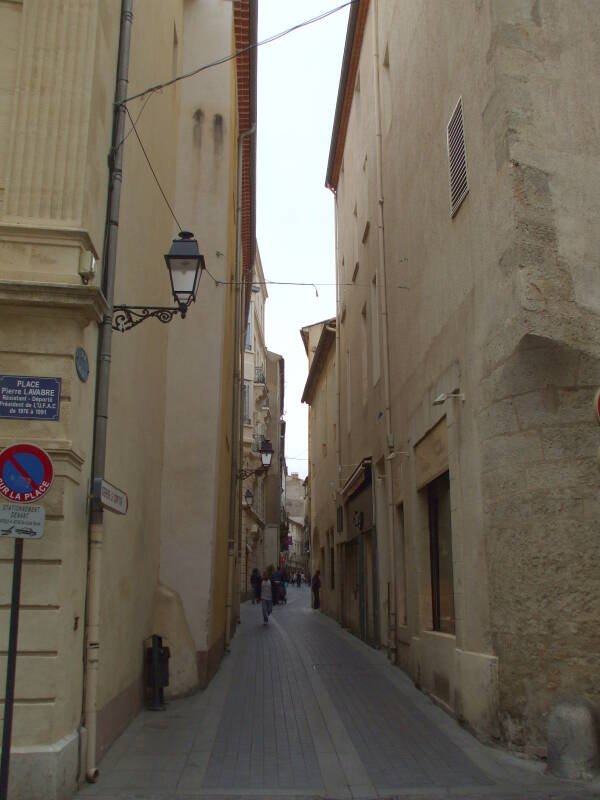
The 48-meter-tall tower of the Cathedral of Saint Nazaire provided a view over the city and its surroundings.
That's the river Orb passing below. From right to left there's a road bridge, a railway bridge, another road bridge, and then an aqueduct, a bridge carrying the Canal du Midi over the river.
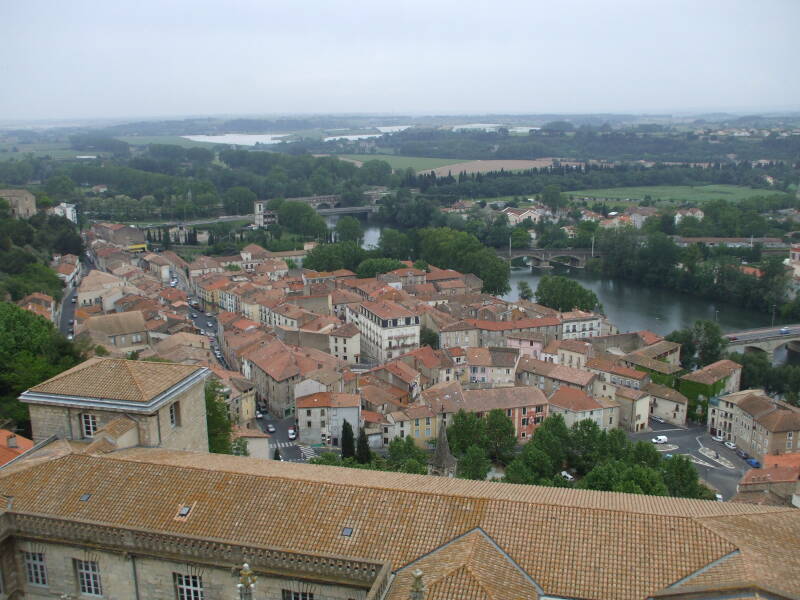
Canal du Midi at Béziers
We're walking along the river Orb on our way to the canal.

The Pont-canal de l'Orb carries the canal over the river. It is said to be the first such canal bridge.
Originally there was no bridge. The canal had a lock lowering boats down to the river. They made their way across the hazardous waterway, as long as the river wasn't running too low or too high, and then back up in another lock to join the next segment of the canal.
Then the aqueduct opened in 1858, greatly simplifying passage. Its seven stone spans carry the canal some 12 meters above the river.
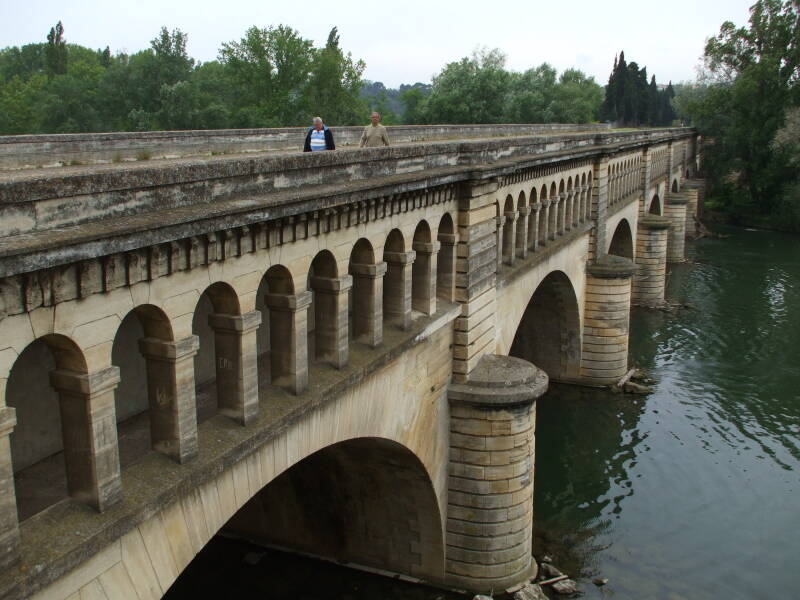
There are now 55 aqueducts or canal bridges on the Canal du Midi. This one is by far the longest, at 240 meters. It's 28 meters wide, with tow paths on either sides.
The Canal du Midi averages 20 meters wide at the surface, 10 meters wide at its base. It is designed to be at least two meters deep throughout, although the recommended draft is no more than 1.5 meters. The Canal Latéral à la Loire is deeper. Three to four meters, based on my experience retrieving an deck umbrella from the bottom. It's difficult to bring a large open umbrella up from the bottom of a canal. They tend to land upside-down, like a large sea anchor.
The canal is 240 kilometers long with 70 locks. We will cover 157 kilometers and pass through 62 locks.
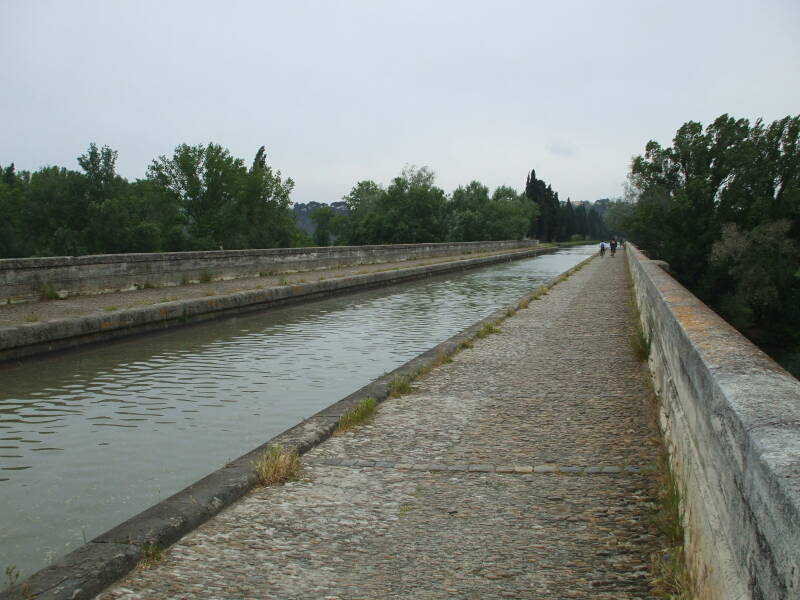
The Albigensian Crusade
The Albigensian Crusade, also called the Cathar Crusade, was a nightmare, as crusades are.
The Cathars, from the Greek καθαροί or "pure ones", were a Christian gnostic or dualist movement in the 12th to 14th centuries in southern Europe. They were sometimes called Albigensians because the movement in southern France arose in the city of Albi, close to here.
It was influenced by Богомилство or Bogomilstvo, a movement in the First Bulgarian Empire. The Bogomils called for a return to what they considered to be the early Christian teaching, rejecting the ecclesiastical hierarchy. The movement spread through the Byzantine Empire, later reaching Kievan Rus', Italy, and France.
The Bogomils and the Cathars were dualists, distinguishing between a world within the body and a world outside the body. They believed in two opposing deities. The good God was the God of the New Testament, the creator of the spiritual realm. The evil God was the God of the Old Testament, creator of the physical world, and identified as or associated with Satan. Humans were the sexless spirits of angels trapped in the material realm of the evil God of the physical world. Humans were destined to be reincarnated until they achieved salvation through the Consolamentum, a spiritual ceremony removing all sin and inducting the believer into the next higher level as a Perfect or Cathar. And, just as in early Christianity, women could play prominent roles.
The Cathars didn't see a need for the Roman Catholic sacrament, and certainly not for the Roman Catholic hierarchy, which they saw as corrupt. And it certainly was.
This attitude, of course, led to violent papal suppression. Pope Innocent III launched a twenty-year military crusade to eliminate Catharism in the Languedoc region of southwestern France. It became especially bloody along what later became the path of the Canal du Midi.
The Cathedral of Saint Nazaire as rebuilt post-crusade overlooks the river.
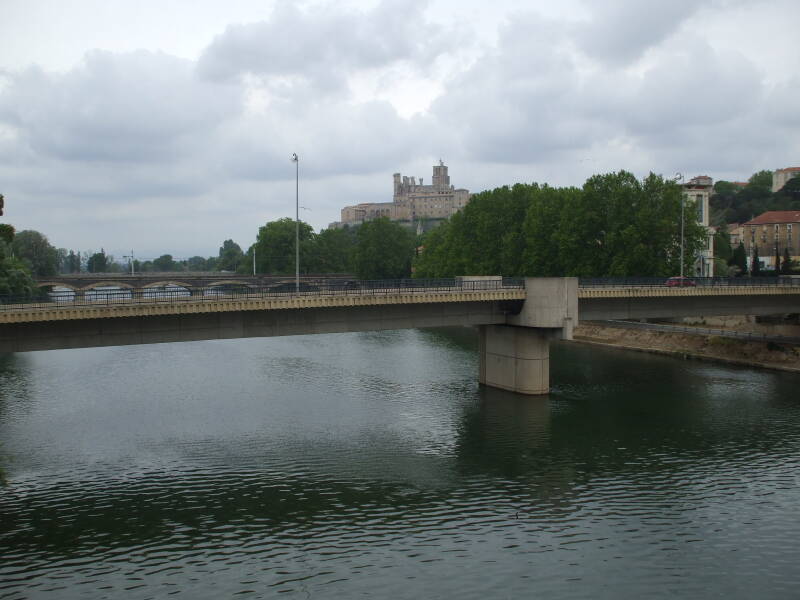
The first boats on the canal were small barges with sails on easily lowered masts. The boats were moved by sail and also pulled by teams of men.
Human labor was cheaper than animal labor in the Middle Ages. For purely practical reasons you had to expend some effort and expense to keep animals alive. Humans, not so much. Moving into the Early Modern era, human labor began to receive some limited care and support. By the mid 1700s, horses had taken over from the men. Either way, broad paths beside the canal gave your boat-pulling mammals a place to work.
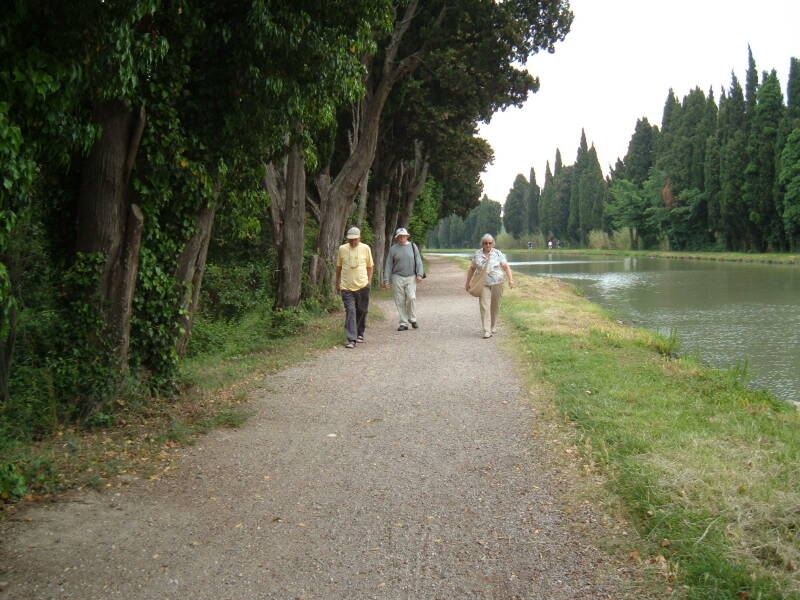
In 1834, steam tugs began pulling barges across the Étang de Thau, the lagoon with a channel forming part of the eastern end of the canal.
The Étang de Thau is the largest of a string of lagoons along the French coast from the Rhône river to the foothills of the Pyrenees. A central navigation channel marked by buoys is dredged for safe transit leading toward the Rhône delta.
Oyster framesin Normandy
The lagoon is open to the Mediterranean, with an economically important shellfish industry. 750 oyster farmers maintain some 2,750 oyster tables, frames on which they raise oysters in mesh bags. They collect some 13,000 tonnes of oysters annually, about 8.5% of France's consumption. The lagoon also produces some 3,000 tonnes of mussels each year.
The Fonserannes staircase locks raise and lower boats a total of 21.5 meters over a distance of 300 meters. It's now a series of six active locks.
Nearly 12,000 laborers worked for fifteen years to build the canal. It was entirely manual labor, local farmers and workers wielding shovels and pickaxes. Riquet paid his workers unusually well. He also gave them benefits never seen before, including paying them on non-working rain days, no work on Sundays and public holidays, and paid sick leave.
Many of the workers were women who came from former Roman bath colonies in the Pyrenees mountains. Roman-era hydraulics were still in use there, maintained through traditions going back to Roman times.
Civil engineering in the mid to late 1600s was largely limited to building fortresses. Hydraulics work focused on pumping water out of mines. Military engineers didn't know how to build canals, but the women from the Roman bath colonies did.

The original lock gates were wooden, with long lever arms to manually open and close them, and hand-cranked valves.
Today the gates are all metal, with electrical or hydraulic mechanisms. Instead of turning cranks, as one still does on the Canal Latéral à la Loire, the lock operators here use electrical control panels.
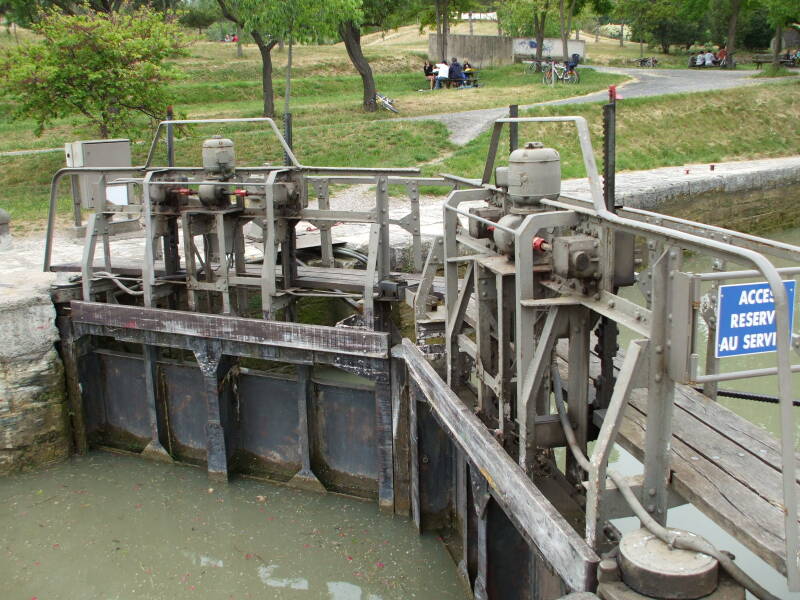
The motors on the gates operate valves allowing water to flow through the gate.
The motors on the walls on either side of the lock open and close the gates.

The first few locks on the canal were rectangular, with straight sides. However, the side walls of these tended to collapse.
The locks were built in oval shapes, using the arch turned on its side. They were built from rectangular cut stones, then sealed with lime. The standard lock was 30.5 meters long, 6 meters wide at the gates, and 11 meters wide in the center. So, 30 meter length with a 6 meter beam and 1.5 meter draft is the limiting gauge of the canal, the maximum dimensions for a boat.
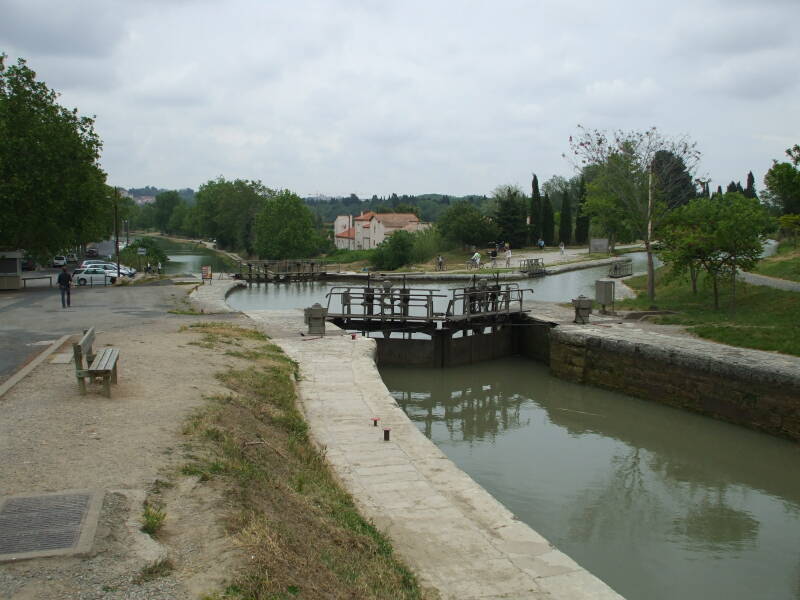
Below we're looking at a lock chamber with water at its lowest level. Its lower gate, behind us, is open to the lower body of water. The upper chamber is full, with some water coming over the top of the upper gate.
The locks on Canal du Midi have large sills, ledges extending into the lock from the upper gate. Many extend at least twice as far as this one does. Sills are no problem when you're traveling upstream. But when you're moving down in a lock, you must make sure that your boat is beyond the sill of the upper gate. A boat moving downstream with its stern too close to the upper gate risks damage to the rudder and propeller, and even hull damage.
The lock operator will close the lower gate, then open valves to fill this chamber to the line where the walls are wet. That will lower the water level in the next chamber. Then they will open this gate and a boat can proceed to the next chamber, or down from the next chamber to this one.
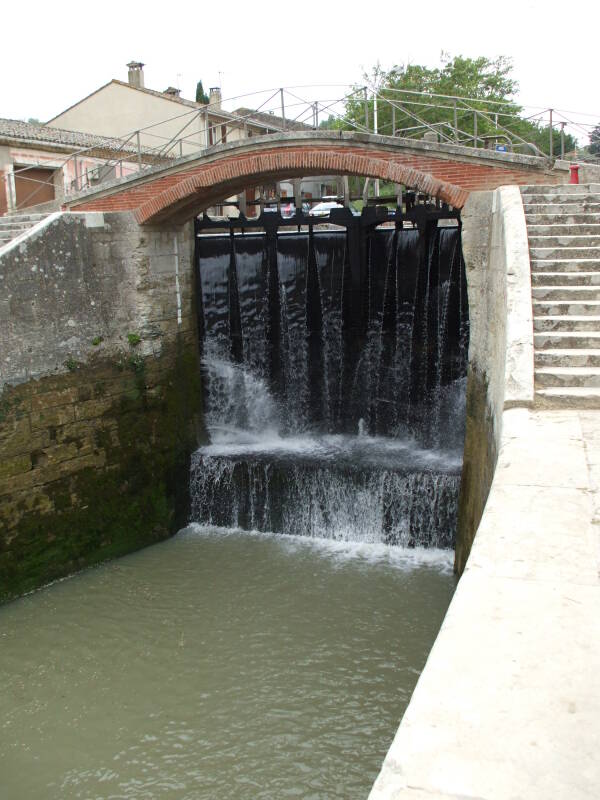
Several boats were lined up to descend the Fonserannes staircase of locks.
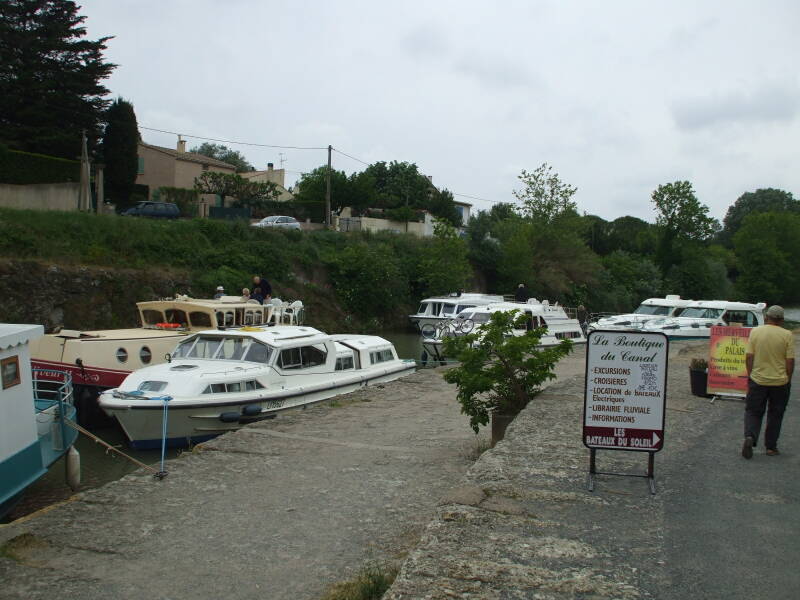
When the operators start moving these boats down, they will put multiple boats in each lock chamber to move everyone through in as few cycles as possible.
Once these have descended and are moving on down the canal, a group of boats gathering at the bottom will be brought up.

We could look back over a vineyard to Béziers, with its cathedral on the horizon.

The Massacre of Béziers
Pope Innocent III had called for a Crusade against the Cathars. They had been condemned by eight church councils, the last of which called for their imprisonment and the seizure of their property. Innocent III announced that any French nobleman taking up arms against the Cathars could seize and keep their property.
AvignonPapacy
This was around the period when the French crown began controlling the Papacy, shortly before the time when there was a series of Popes based in Avignon, competing for power with Popes in Rome, and, at times, other western European cities.
An army consisting partly of knights and their supporters, mostly from northern France, assembled in Lyon. They were joined by routiers or mercenaries, and pilgrims eager to get a piece of the action. The army departed from Lyon in early July 1209. They had been told that they had "crusader indulgence", absolving their sins and guaranteeing that they would suffer no punishment in the afterlife.
They reached the outskirts of Béziers on 21 July 1209. They told the Roman Catholic Bishop to tell the people that they would be spared if they turned over the heretics.
The local people wouldn't hand over the Cathars. The Bishop asked the Cathars to surrender themselves to the crusader army, but they wouldn't.
On 22 July 1209 the crusader army entered a city gate. The army was commanded by Arnaud Amalric, the Abbot of Citeaux. He is said to have commanded the army, "Caedite eos; novit enim Dominus qui sunt eius." That is, "Kill them all; God will sort them out."
The routiers or mercenaries moved through the streets killing everyone. The citizens sought refuge in the churches. The routiers broke into the churches and killed everyone inside. They burned the Cathedral of Saint Nazaire, which collapsed and killed everyone seeking shelter inside. A few parts of the Romanesque cathedral of that era survived, and was used as a base for the reconstruction project started in 1215.
The cathedral had been built on the site of an ancient Roman temple dedicated to Augustus and his wife Livia. There were written mentions of a Christian church there in the 8th century CE. The restoration of the cathedral and other churches, plus the rest of the city, continued into the 15th century.
The knights let the massacre proceed, although they soon intervened to claim the city's best plunder for themselves. To keep the knights from getting all the good stuff, the routiers set fire to the buildings and destroyed almost all of the city.
There was little plunder left for the army, but the good news for the Pope was that almost all of the city's inhabitants were killed. The Albigensian Crusade led to the establishment of the Dominican Order and the Medieval Inquisition.
Terror spread through Languedoc, and many castles and town surrendered immediately. The fortified city of Carcassonne, which we visited later on this trip, fell within a month.
The rapacious crusader army quickly lost the support of the local Roman Catholic population and became a hated occupying force.
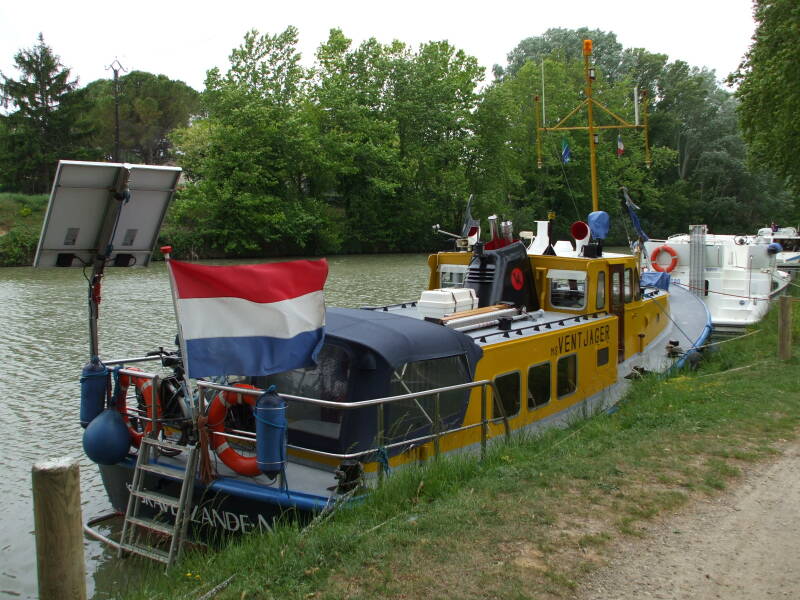
A few centuries post-crusade, once the canal was built, boats moved freight, mail, and passengers. Wheat and wine were the bulk of the freight. The mail barges initially transported passengers in simple shelters on the decks. This evolved into enclosed cabins, with private cabins for first class and a shared cabin for second class. Some boats had first class lounges where dinner was served.
ThomasJefferson
in France
Thomas Jefferson was the U.S. Ambassador to France before becoming U.S. President. In 1787 he came to the Languedoc area to travel along the Canal du Midi to study it. He hoped that the U.S. could build a similar canal to join the Potomac river at Washington, D.C., over the Appalachian mountains to the Ohio river, and from there onward to Lake Erie. In the letters between Jefferson and George Washington during Jefferson's ambassadorship, there seems to be no letter that doesn't at least mention canals, if not focus entirely on them.
Amazon
ASIN: 0792254864
The Canal du Midi greatly increased the market for the local producers. By the 1800s it had become a four-day trip along the length of the canal from Toulouse to Sète. 1856 was the peak year, with over 110 million tonne-kilometers of freight and nearly 100,000 passengers.
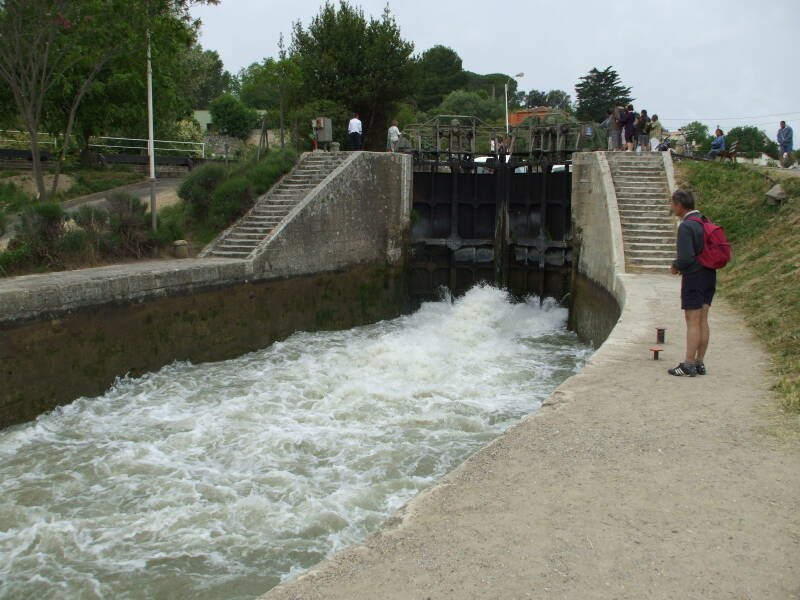
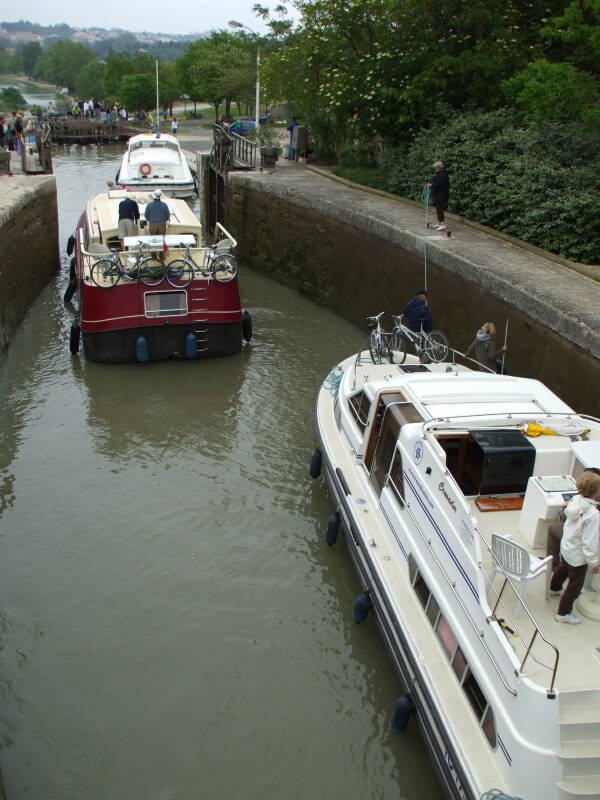
We walked back to Béziers along the canal.

We explored Béziers some more, and got dinner along the main avenue through the center.
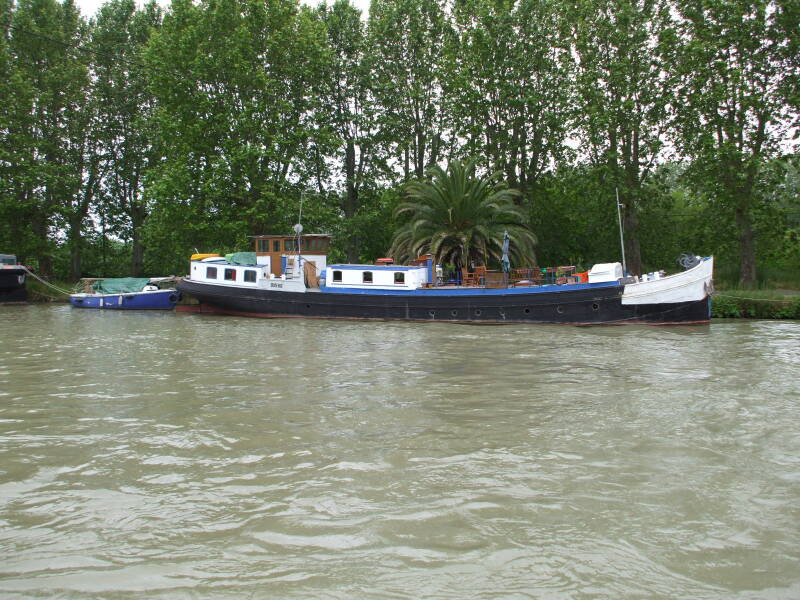
In the morning we would check out of our hotel and go pick up our boat.
